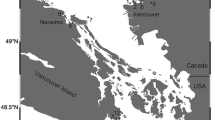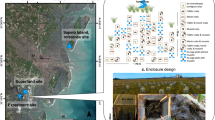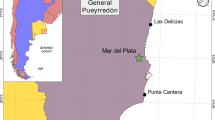Abstract
Polychlorinated biphenyl (PCB) concentrations were quantified in lower trophic level consumers of the Lake Erie western basin food web to assess the capacity of PCBs to discriminate among trophically similar species inhabiting different compartments of the same ecosystem. Zooplankton were characterized by higher proportions of less chlorinated and hydrophobic homologs relative to zebra mussel (Dreissena polymorpha), mayfly (Hexagenia limbata) and emerald shiner (Notropis atherinoides) samples. PCB biota-sediment accumulation factors (BSAF) differed significantly among species with zebra mussels and emerald shiners having the highest BSAFs. Principal components analysis of sample PCB profiles reflected the contrasting pelagic and benthic habitats occupied by filter-feeding zooplankton and zebra mussel samples. Benthic mayfly PCB profiles were characterized by increasingly hydrophobic (logK OW ≥ 6.9) congeners with more variable emerald shiner profiles reflecting the greater mobility and extent of spatial habitat integration achieved by this secondary consumer. These results contribute to growing evidence for the use of PCBs as ecological tracers in aquatic ecosystems.



Similar content being viewed by others
References
Barbiero RP, Rockwell DC (2008) Changes in the crustacean communities of the central basin of Lake Erie during the first full year of Bythotrephes longimanus invasion. J Great Lakes Res 34:109–121
Chapman PM (2016) Sediment contaminant bioaccumulation: with or without gut contents. Bull Environ Contam Toxicol 97:151–152
Daley JM, Corkum LD, Drouillard KG (2011) Aquatic to terrestrial transfer of sediment associated persistent organic pollutants is enhanced by bioamplification processes. Environ Toxicol Chem 30:2167–2174
deBruyn AMH, Gobas FAPC (2004) Modelling the diagenetic fate of persistent organic pollutants in organically enriched sediments. Ecol Mod 175:405–416
Edmunds GF, Jensen SL, Berner L (1976) The mayflies of north and central America (New edition). University of Minnesota Press
Epplett TD, Gewurtz S, Lazar R, Haffner GD (2000) Seasonal dynamics of PCBs in the plankton of Lake Erie. J Great Lakes Res 26:65–73
Gewurtz SB (2000) Exposure dynamics of polycyclic aromatic hydrocarbons and polychlorinated biphenyls in the food web of western Lake Erie and the Detroit River. Master of Science Thesis, University of Windsor, Windsor, ON CANADA
Gobas FAPC, Maclean LG (2003) Sediment–water distribution of organic contaminants in aquatic ecosystems: the role of organic carbon mineralization. Environ Sci Technol 37:735–741
Hawker DW, Connell DW (1988) Octanol water partition coefficients of polychlorinated biphenyl congeners. Environ Sci Technol 22:382–387
Hebert CE, Haffner GD (1991) Habitat partitioning and contaminant exposure in cyprinids. Can J Fish Aquat Sci 48:261–266
Lazar R, Edwards RC, Metcalfe CD, Metcalfe T, Gobas FAPC, Haffner GD (1992) A simple, novel method for the quantitative analysis of coplanar (non-ortho substituted) polychlorinated-biphenyls in environmental samples. Chemosphere 25:493–504
MacDonald CR, Metcalfe CD, Balch GC, Metcalfe TL (1993) Distribution of PCB congeners in 7 lake systems-interactions between sediment and food web transport. Environ Toxicol Chem 12:1991–2003
Mackay D (1982) Correlation of bioconcentration factors. Environ Sci Technol 16:274–278
Makarewicz JC (1993) A lakewide comparison of zooplankton biomass and its species composition in Lake Erie, 1983–1987. J Great Lakes Res 19:275–290
McLeod AM, Arnot JA, Borgå K, Selck H, Kashian DR, Krause A, Paterson G, Haffner GD, Drouillard KG (2015) Quantifying uncertainty in the trophic magnification factor related to spatial movements of organisms in a food web. Int Environ Assess Man 11:306–318
Morrison HA, Gobas FAPC, Lazar R, Haffner GD (1996) Development and verification of a bioaccumulation model for organic contaminants in benthic invertebrates. Environ Sci Technol 30:3377–3384
Paterson G, Drouillard KG, Haffner GD (2006) An evaluation of stable isotopes and polychlorinated biphenyls as bioenergetic tracers in aquatic systems. Can J Fish Aquat Sci 63:628–641
Pothoven SA, Vanderploeg HA, Ludsin SA, Höök TO, Brandt SB (2009) Feeding ecology of emerald shiners and rainbow smelt in central Lake Erie. J Gt Lakes Res 35:190–198
Safe SH (1994) Polychlorinated-biphenyls (PCBs): environmental impact, biochemical and toxic responses, and implications for risk assessment. Crit Rev Toxicol 24:87–149
SYSTAT (2004) SYSTAT for Windows, Version 11.0 SYSTAT Software Inc. Richmond, CA
Warton DC, Hui FKC (2011) The arcsine is asinine: the analysis of proportions in ecology. Ecology 92:3–10
Acknowledgements
The authors thank Karen Balkwill and students enrolled in the Great Lakes Field Biology Program at the Great Lakes Institute for Environmental Research, Windsor, ON. Funding support for this research was provided by the State University of New York’s College of Environmental Science and Forestry, the Canada Foundation for Innovation, and the Natural Sciences and Engineering Research Council of Canada.
Author information
Authors and Affiliations
Corresponding author
Rights and permissions
About this article
Cite this article
Pitt, J.A., Drouillard, K.G. & Paterson, G. Polychlorinated Biphenyl Bioaccumulation Patterns Among Lake Erie Lower Trophic Level Consumers Reflect Species Ecologies. Bull Environ Contam Toxicol 98, 65–70 (2017). https://doi.org/10.1007/s00128-016-1987-0
Received:
Accepted:
Published:
Issue Date:
DOI: https://doi.org/10.1007/s00128-016-1987-0




